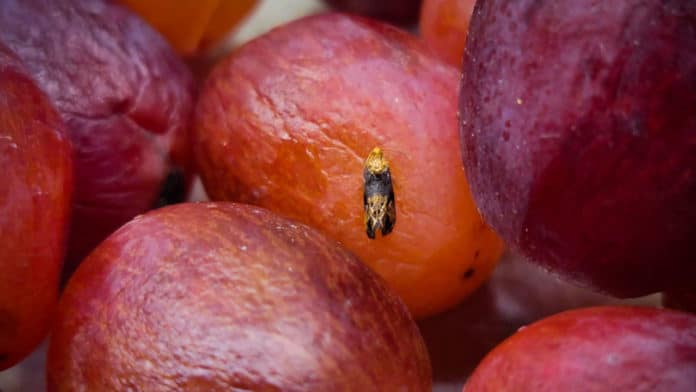The grape berry moth is a crucial pest of grapes that is distributed in the United States east of the Rocky Mountains and eastern Canada.
The larvae of this insect can cause serious damage to commercial vineyards by feeding on the blossoms and berries. Infested berries may appear shriveled with fine webbing. Damage by grape berry moth may increase mold, rots, and numbers of fruit flies. While grape berry moth larvae may only damage a few berries in a cluster, it is impractical for growers to remove damaged berries and webbing from clusters. Hosts include wild and cultivated grapes.
But, how the moths home in on berries from the wider landscape- remains unclear. Through a new study, scientists at Cornell University explored how these pests find their target amid a sea of other plants in the landscape.
Scientists started with hypothesizing that the grapes may contain a unique profile of volatile compounds that only moths can recognize. They then created a study model for studying the proximate mechanisms of long-distance olfactory-mediated, host-plant location, and selection by a specialist phytophagous insect.
Charles Linn, a senior research associate at Cornell, said, “Chemical cues, signals, are used by almost all insects to locate resources in their habitats, such as mates or host plants.”
Greg Loeb, professor of entomology at Cornell AgriTech said, “Grape plants produce maybe hundreds of compounds, but the insects are only detecting a subset with their antennae.”
Scientists ran gas chromatography, electro-antennal detection, and mass spectrometry analyses coupled with behavioral tests in a wind tunnel. They identified 11 volatile organic compounds emitted by grapes that the moths detected. Though these compounds appear in particular ratios in grapes, they are common and are shared by most plants, including gray dogwood and apples.
When scientists used the grape vine odors to lure the moths into traps, the method worked, but ineffectively. In tunnel tests, scientists found the moths flew upwind at the same rates toward both plant clippings and extracts of volatiles from grapes, dogwood, or apples.
Loeb said, “The berry moth wasn’t showing clear evidence of discrimination based on these compounds. We suggest that maybe plant-eating arthropods are using this common volatiles to find the correct habitat, and then using other cues to zero in on where they are going to lay their eggs.”
Linn said, “Chemical cues, signals, are used by almost all insects to locate resources in their habitats, such as mates or host plants.”
Greg Loeb, professor of entomology at Cornell AgriTech said, “Grape plants produce maybe hundreds of compounds, but the insects are only detecting a subset with their antennae.”
Although further study is required to determine better the clues, the moths use to find the berries. Even if no deterring volatiles were found, the study still offers clues for breeders to perhaps develop varieties with tweaked ratios of volatiles to throw insects off the scent.
The study is published Nov. 21 in the Journal of Chemical Ecology and was funded by the U.S. Department of Agriculture.
